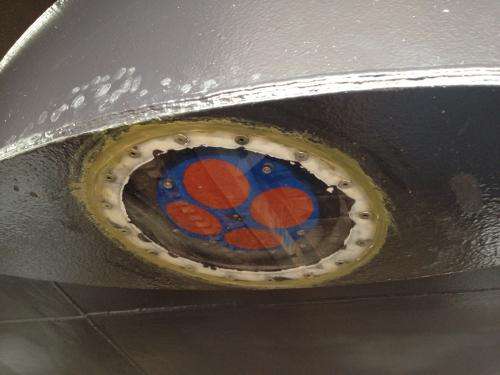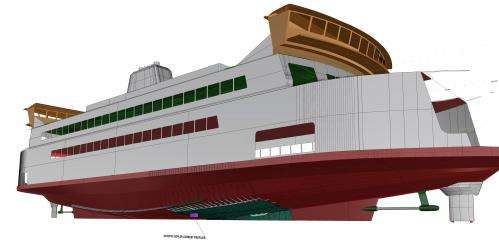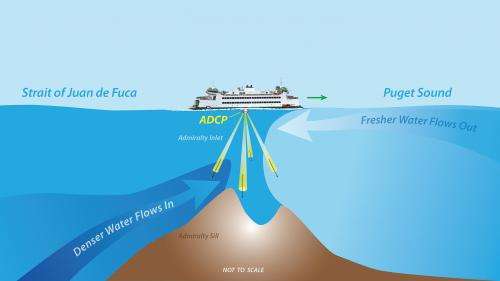Instrument will monitor flow in Puget Sound

(Phys.org) —It's not just vacationers who will be traveling on the ferries between Port Townsend and Coupeville this summer. A new partnership among the Washington Department of Ecology, the University of Washington and other groups is riding on Washington State Ferries to improve understanding of water circulation in Puget Sound.
Researchers have installed a water monitoring sensor on the hull of the 64-car Salish ferry that crosses Admiralty Inlet. The sensor measures the direction and speed of the water from surface to seafloor across the entire channel.
Understanding how water flows through Puget Sound's myriad channels will help to better understand the local marine environment.
"Admiralty Inlet is the gateway between the ocean and Puget Sound,"said Jim Thomson, an oceanographer with the UW Applied Physics Laboratory. "We are measuring the flow through that gateway."
Thomson is especially interested in tracking intermittent tongues that bring low-oxygen water up from the deep ocean. Lack of oxygen has led to fish kills in Hood Canal, and people want to know whether regulating sewage systems or runoff could prevent the problem.
"Under certain conditions deep water from the ocean will come up and sneak into Puget Sound and possibly contribute to low oxygen levels. Right now there is limited data, so it's hard to say when or how much this happens," Thomson said. "We really are an urban water system, but there's also this very natural process connected to the ocean that changes our water quality."
Thomson has worked for the Department of Ecology and others to study Admiralty Inlet for tidal energy. His team maintained a seafloor sensor for over four years to measure currents and oxygen levels in the fast-flowing waters. But that one sensor could only see a small sliver, not the whole picture.
"Monitoring of Puget Sound is important because it helps us understand long-term trends and changes over time," said Carol Maloy, a marine scientist at the state Department of Ecology. "Monitoring helps us understand if changes are natural or human-caused. If changes are human-caused, perhaps there are steps we can take to reverse problems."
The sensor on the ferry is an Acoustic Doppler Current Profiler. It sends tiny sound waves, or pings, down through the water. The technology is very similar to the depth-sounders and fish-finders used on many recreational vessels.
Particles in the water reflect the sound back. The time it takes for the echoes to return to the profiler is used to calculate the distance beneath the ship, and the shift in the wavelength of the returning ping is used to calculate the water's direction and speed.

The ferry data will be equivalent to placing 32 sensors across the 3 ½-mile (6 km) stretch of water, Thomson said, and will be able to track flow at every 3 feet of depth through the channel.
Tracking flow across the entire stretch can help better understand and predict the ocean's influence on Puget Sound oxygen, acidity and nutrient levels, and the movement of pollution or natural substances with ocean currents.
"This is an example of a creative and cost-effective collaboration helping us better understand the complex marine ecosystem of Puget Sound," said Ken Dzinbal of the Puget Sound Partnership, which is a partner on the project.
UW researchers modified the instrument to automatically begin recording data once the ferry starts to move and begin to upload the data wirelessly to computer servers on land as the vessel approaches shore. They worked with ferry engineers this spring to install the sensor and check the accuracy of the data.
They'll install a second system later this year on the Kennewick, which travels the same route.
Observations are available to the public now from the Department of Ecology and on the UW Applied Physics Lab website, and in a few weeks will be available in more graphical form. In about a year there should be enough data for a student to start looking for trends, Thomson said.

UW researchers modified the instrument to automatically begin recording data once the ferry starts to move and begin to upload the data wirelessly to computer servers on land as the vessel approaches shore. They worked with ferry engineers this spring to install the sensor and check the accuracy of the data.
They'll install a second system later this year on the Kennewick, which travels the same route.
Observations are available to the public now from the Department of Ecology and on the UW Applied Physics Lab website, and in a few weeks will be available in more graphical form. In about a year there should be enough data for a student to start looking for trends, Thomson said.
Provided by University of Washington



















